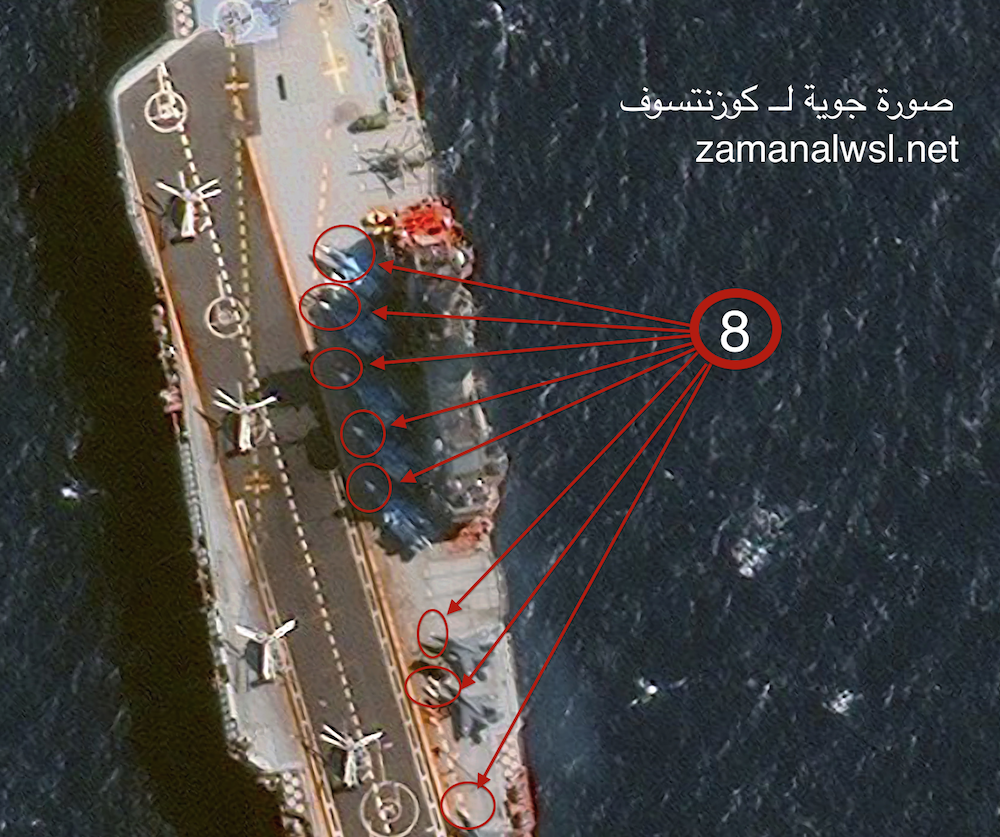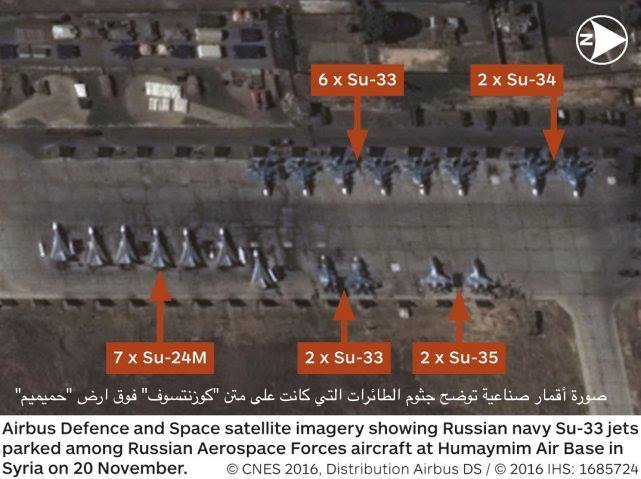(Zaman Al Wasl- In a recent incident, Moscow lost a major betting card it was playing to market and exaggerate the ability of the Russian equipment based on the equipment’s proven track record in the conflict in Syrian.
The Russians suffered a major and expensive loss with the crash of one of its latest and most advanced military warplanes. The event has serious military and economic consequences given the Russians dependence on sales of their military technologies, but the event more seriously counters Russia’s claims of progress, its advanced military products, and its position as a major country.
In this special report, Zaman al-Wasl casts light on the disasterous end for the high hopes Moscow had in sending a prize, newly equipped, aircraft carrier on an almost 10,000 kilometer journey to Syria’s shores. Moscow’s attempt to demonstrate the might, prestige and ascendency not only of the Russian military but also its military technologies backfired on the Kremlin.
The Little Cesar
Moscow was forced to admit that a MiG-KR29 airplane crashed on 13 November. The announcement affects its plans to conduct a realistic media campaign to advertise Russian weaponry based on their performance in the conflict in Syria.
The campaign seeks to reassert the conviction of Russian weapon customers in the merchandise they are buying, reduce potential customers’ hesitation, confirm the might of Russian weaponry, and announce the return of Putin’s Russia to the global scene as a major power under the leadership of the ‘Little Cesar’ who brings down the great ones.
Since the start of Russia’s intervention to the advantage of the regime, Moscow has repeatedly stated that the Syrian territory is the ideal field to experiment with weapons and ammunition to prove their power and effectiveness, and raise the status of the Russian military products in the eyes of its customers, old and new.

On this basis, the Kuznetsoz, an aircraft carrier, was sent on the approximately 10,000 kilometer journey to Syria’s shores.
The aircraft carrier arrived despite the difficulties it faced regarding refueling as Spain and Malta both refused its request. The aircraft carrier arrives not only to participate in the bombing and destruction of Aleppo, but to prepare the climate in Russia for multi-billion weapon deals whether by convincing customers of the effectiveness of the Russian weaponry or pressuring them to buy Russian weapons.
The facts Zaman al-Wasl will reveal in this report, demonstrate that the MiG-KR 29 crash was a hard blow to the Russians and it has many repercussions for the Russian military and manufacturing as the crash happened on the Kuznetsoz, and involved the destruction of one of the latest Russian fighter planes at the hands of one of Russia’s most professional and experienced pilots.
Zaman al-Wasl relies on facts published in the Russian Gazzetta newspaper which demonstrated that the MiG-KR 29 crashed on 13 November as both its engines stopped working.
Three MiG-KR 29 airplanes took off from the Kuznetsoz aircraft carrier to execute missions over Syria, and following the end of their task returned to the aircraft carrier. The first plane landed without problem; however, the second airplane and the carrier crew faced technical difficulties as one of cables used to tie down the plane snapped, leading the crew scurrying to sort out the issue.
They eventually used the fourth cable tie as the third was tied around the second making it impossible to use. In the emergency to tie down the second airplane, no cable was left for the third airplane to enable its pilot to land.

The crew aboard Kuznetsoz found no solution except to ask the pilot of the third MiG-KR29 to circle above the aircraft carrier until they fix the cable situation to enable the airplane to land.
All airplanes specialized to land on aircraft carriers have special hooks at the back of the plane that must be tied to a cable on board the aircraft carrier to ensure the airplane can land decrease their speed to a minimum, and ensure it lands on the runway strip and not fall into the sea.
The Kuznetsoz is equipped with four cables, the first is close to the start of the runway so using it to land presents a danger for the airplanes about to take off. That leaves the second and third cables, and the fourth cable is considered an emergency cable of sorts.
As the third MiG-KR29 did the turn in the sky waiting for the crew to fix the problem, the crew saw the airplane, whole, crash into the sea as the pilot ejected himself from it moments before impact.
According to Gazzatta newspaper, the airplane crashed due to the failure of both its engines after fuel stopped flowing towards the engines. It remains unclear if this was a technical problem or the airplane ran out of fuel.
In reviewing these details, it is possible to present the mistakes and mismanagement which eats away at the body of the Russian military whether at the level of equipment or personnel.
The Russians’ first mistake was sending a sole aircraft carrier. The failure of all four cables on the board the Kuznetsoz raises other questions as the aircraft carrier underwent a restoration and rehabilitation workshop for 40 days before its first journey; the workshop ended on 1 October, and it began its journey to Syria on 15 October.

The other mistake regards the MiG-KR29, which crashed into the sea. This was a long awaited warplane as the Russian navy wanted to use it to replace the Sukhoi 33. In 2012, the Russian military announced that the MiG-KR29 would replace the Sukhoi 33 bomber jets, and this was a great source of pride for Moscow and Putin.
The new airplanes were installed on the northern fleet and Kuznetsoz especially which was to serve as a mobile airport for these advanced warplanes. The Russian military announced in August 2016 the success of the first landing of a MiG-KR29 on Kuznetsoz, to highlight to its audience return of the the power of the Russian army.
The crash of the MiG-KR29 while it is considered to be still in its test phase and at a time when Russia is heavily marketing the airplane comes as a severe blow.
Scrap Metal Projects
Regarding the crew on board the Kuznetsoz responsible for the safe landing of the airplanes and their pilots, their failure to deal with the situation demonstrates the severe lack of preparation of the Russian air and naval forces.
The severity of the catastrophy is further exacerbated by the fact the Russian pilot who was flying the third MiG-KR29 is considered one of the most profession and experienced pilots who served as the head of airplane security division in the Black Sea fleet. The pilot has also undertaken over 200 landing operations on the Kuznetsoz.
Regardless of the pilot and his flyng history, the Russians would never entrust an expensive and new airplane such as the MiG-KR29, one airplane costs 35 million US Dollars, to a beginner or mid-level experienced pilot, especially knowing the pilot would have to undertake take offs and landings on the Kuznetsoz with its remarkably short runway.
The massive failure of the Kuznetsoz and this loss, has rendered the aircraft carrier a piece of scrap metal located before the Syrian coast. The expense and cost of sailing it from the north to Syria has not only gone to wait, but it also created a situation of shame and reflected negatively on Russia’s attempts to extoll is military and military products. The Kuznetsoz is no longer in active service at the present time.
Here We Are
Regarding the evidence that the Kuznetsoz is no only in active service, Jana’s Defense Weekly published a report which confirm using satellite imagery and data analysis that the Russian airplanes which were on the aircraft carrier are now based in Hmeimem airport in Latakia’s countryside.
Russia grew extensively, when some reports spoke of the Kuznetsoz’s destruction and that it was issuing black smoke during its journey, and its need for a barge to drag it to port after it broke down in its journey to Syria…
`
Moscow was so prideful that high ranked consults of the Russian Ministry of Defense denied that the black smoke is the sign the carrier is suffering a defect, and claimed that the black smoke was just part of a naval tradition to say, “Here we pass by you!” An explanation even al-Dunya channel, which has had many a memorable and preposterous explanations did not dare to make.
Perhaps the high ranking military consult’s explanation is closer to the explanation of those who claimed that those escaping the regime bombing in Idlib went to visit their Turkish relatives across the border, and will return. Perhaps it is closer to Buthayna Shaban claiming that the children who were killed in the regime chemical attack in the Eastern Ghouta were children kidnapped by the armed groups from the coastal area and killed in Damascus’ suburbs!
















Comments About This Article
Please fill the fields below.